Detailed External Environmental Analysis of Anchor Dairy's Business
VerifiedAdded on 2021/04/17
|5
|998
|122
Report
AI Summary
This report provides an external environmental analysis of Anchor Dairy, a leading company in New Zealand's dairy industry. It examines three key external factors impacting the business: economic factors, technological advancements, and social considerations. The analysis highlights the positive impact of the dairy industry on the New Zealand economy, the company's adaptation of improved technologies, and its engagement in socially responsible practices. The report discusses the global demand and price of dairy products, the integration of modern technologies in farm management, and Anchor Dairy's commitment to community programs and environmental protection. References from various sources are included to support the analysis.
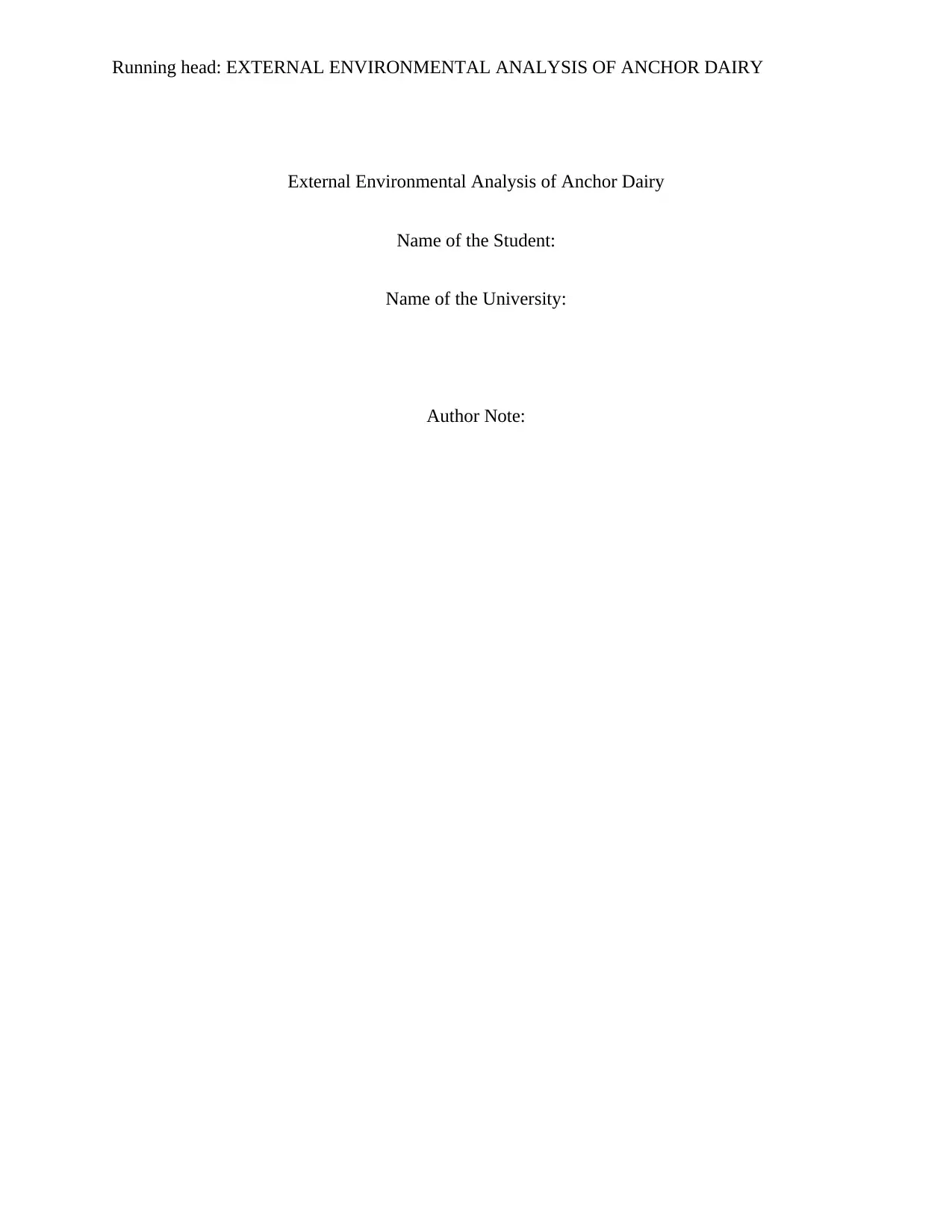
Running head: EXTERNAL ENVIRONMENTAL ANALYSIS OF ANCHOR DAIRY
External Environmental Analysis of Anchor Dairy
Name of the Student:
Name of the University:
Author Note:
External Environmental Analysis of Anchor Dairy
Name of the Student:
Name of the University:
Author Note:
Paraphrase This Document
Need a fresh take? Get an instant paraphrase of this document with our AI Paraphraser
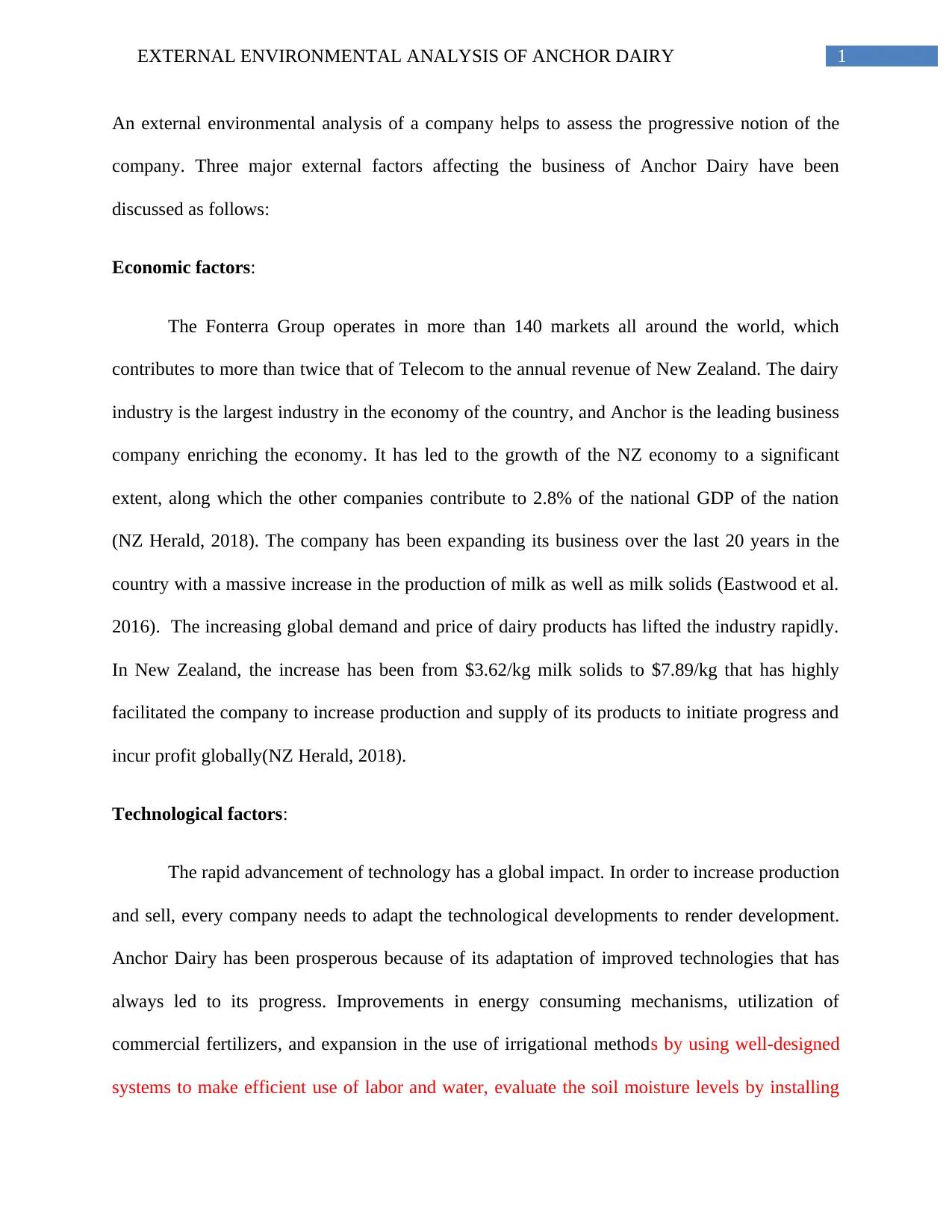
1EXTERNAL ENVIRONMENTAL ANALYSIS OF ANCHOR DAIRY
An external environmental analysis of a company helps to assess the progressive notion of the
company. Three major external factors affecting the business of Anchor Dairy have been
discussed as follows:
Economic factors:
The Fonterra Group operates in more than 140 markets all around the world, which
contributes to more than twice that of Telecom to the annual revenue of New Zealand. The dairy
industry is the largest industry in the economy of the country, and Anchor is the leading business
company enriching the economy. It has led to the growth of the NZ economy to a significant
extent, along which the other companies contribute to 2.8% of the national GDP of the nation
(NZ Herald, 2018). The company has been expanding its business over the last 20 years in the
country with a massive increase in the production of milk as well as milk solids (Eastwood et al.
2016). The increasing global demand and price of dairy products has lifted the industry rapidly.
In New Zealand, the increase has been from $3.62/kg milk solids to $7.89/kg that has highly
facilitated the company to increase production and supply of its products to initiate progress and
incur profit globally(NZ Herald, 2018).
Technological factors:
The rapid advancement of technology has a global impact. In order to increase production
and sell, every company needs to adapt the technological developments to render development.
Anchor Dairy has been prosperous because of its adaptation of improved technologies that has
always led to its progress. Improvements in energy consuming mechanisms, utilization of
commercial fertilizers, and expansion in the use of irrigational methods by using well-designed
systems to make efficient use of labor and water, evaluate the soil moisture levels by installing
An external environmental analysis of a company helps to assess the progressive notion of the
company. Three major external factors affecting the business of Anchor Dairy have been
discussed as follows:
Economic factors:
The Fonterra Group operates in more than 140 markets all around the world, which
contributes to more than twice that of Telecom to the annual revenue of New Zealand. The dairy
industry is the largest industry in the economy of the country, and Anchor is the leading business
company enriching the economy. It has led to the growth of the NZ economy to a significant
extent, along which the other companies contribute to 2.8% of the national GDP of the nation
(NZ Herald, 2018). The company has been expanding its business over the last 20 years in the
country with a massive increase in the production of milk as well as milk solids (Eastwood et al.
2016). The increasing global demand and price of dairy products has lifted the industry rapidly.
In New Zealand, the increase has been from $3.62/kg milk solids to $7.89/kg that has highly
facilitated the company to increase production and supply of its products to initiate progress and
incur profit globally(NZ Herald, 2018).
Technological factors:
The rapid advancement of technology has a global impact. In order to increase production
and sell, every company needs to adapt the technological developments to render development.
Anchor Dairy has been prosperous because of its adaptation of improved technologies that has
always led to its progress. Improvements in energy consuming mechanisms, utilization of
commercial fertilizers, and expansion in the use of irrigational methods by using well-designed
systems to make efficient use of labor and water, evaluate the soil moisture levels by installing
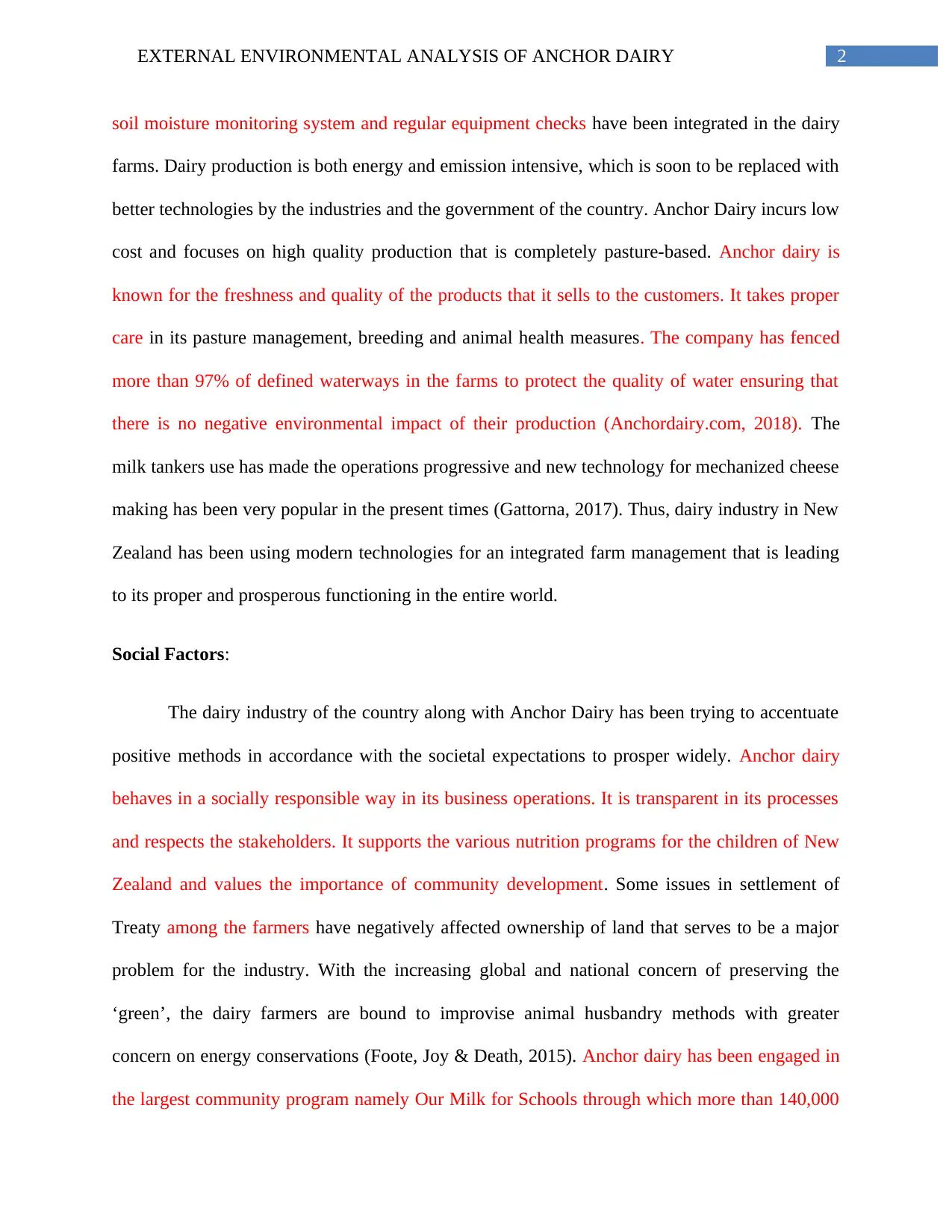
2EXTERNAL ENVIRONMENTAL ANALYSIS OF ANCHOR DAIRY
soil moisture monitoring system and regular equipment checks have been integrated in the dairy
farms. Dairy production is both energy and emission intensive, which is soon to be replaced with
better technologies by the industries and the government of the country. Anchor Dairy incurs low
cost and focuses on high quality production that is completely pasture-based. Anchor dairy is
known for the freshness and quality of the products that it sells to the customers. It takes proper
care in its pasture management, breeding and animal health measures. The company has fenced
more than 97% of defined waterways in the farms to protect the quality of water ensuring that
there is no negative environmental impact of their production (Anchordairy.com, 2018). The
milk tankers use has made the operations progressive and new technology for mechanized cheese
making has been very popular in the present times (Gattorna, 2017). Thus, dairy industry in New
Zealand has been using modern technologies for an integrated farm management that is leading
to its proper and prosperous functioning in the entire world.
Social Factors:
The dairy industry of the country along with Anchor Dairy has been trying to accentuate
positive methods in accordance with the societal expectations to prosper widely. Anchor dairy
behaves in a socially responsible way in its business operations. It is transparent in its processes
and respects the stakeholders. It supports the various nutrition programs for the children of New
Zealand and values the importance of community development. Some issues in settlement of
Treaty among the farmers have negatively affected ownership of land that serves to be a major
problem for the industry. With the increasing global and national concern of preserving the
‘green’, the dairy farmers are bound to improvise animal husbandry methods with greater
concern on energy conservations (Foote, Joy & Death, 2015). Anchor dairy has been engaged in
the largest community program namely Our Milk for Schools through which more than 140,000
soil moisture monitoring system and regular equipment checks have been integrated in the dairy
farms. Dairy production is both energy and emission intensive, which is soon to be replaced with
better technologies by the industries and the government of the country. Anchor Dairy incurs low
cost and focuses on high quality production that is completely pasture-based. Anchor dairy is
known for the freshness and quality of the products that it sells to the customers. It takes proper
care in its pasture management, breeding and animal health measures. The company has fenced
more than 97% of defined waterways in the farms to protect the quality of water ensuring that
there is no negative environmental impact of their production (Anchordairy.com, 2018). The
milk tankers use has made the operations progressive and new technology for mechanized cheese
making has been very popular in the present times (Gattorna, 2017). Thus, dairy industry in New
Zealand has been using modern technologies for an integrated farm management that is leading
to its proper and prosperous functioning in the entire world.
Social Factors:
The dairy industry of the country along with Anchor Dairy has been trying to accentuate
positive methods in accordance with the societal expectations to prosper widely. Anchor dairy
behaves in a socially responsible way in its business operations. It is transparent in its processes
and respects the stakeholders. It supports the various nutrition programs for the children of New
Zealand and values the importance of community development. Some issues in settlement of
Treaty among the farmers have negatively affected ownership of land that serves to be a major
problem for the industry. With the increasing global and national concern of preserving the
‘green’, the dairy farmers are bound to improvise animal husbandry methods with greater
concern on energy conservations (Foote, Joy & Death, 2015). Anchor dairy has been engaged in
the largest community program namely Our Milk for Schools through which more than 140,000
⊘ This is a preview!⊘
Do you want full access?
Subscribe today to unlock all pages.

Trusted by 1+ million students worldwide
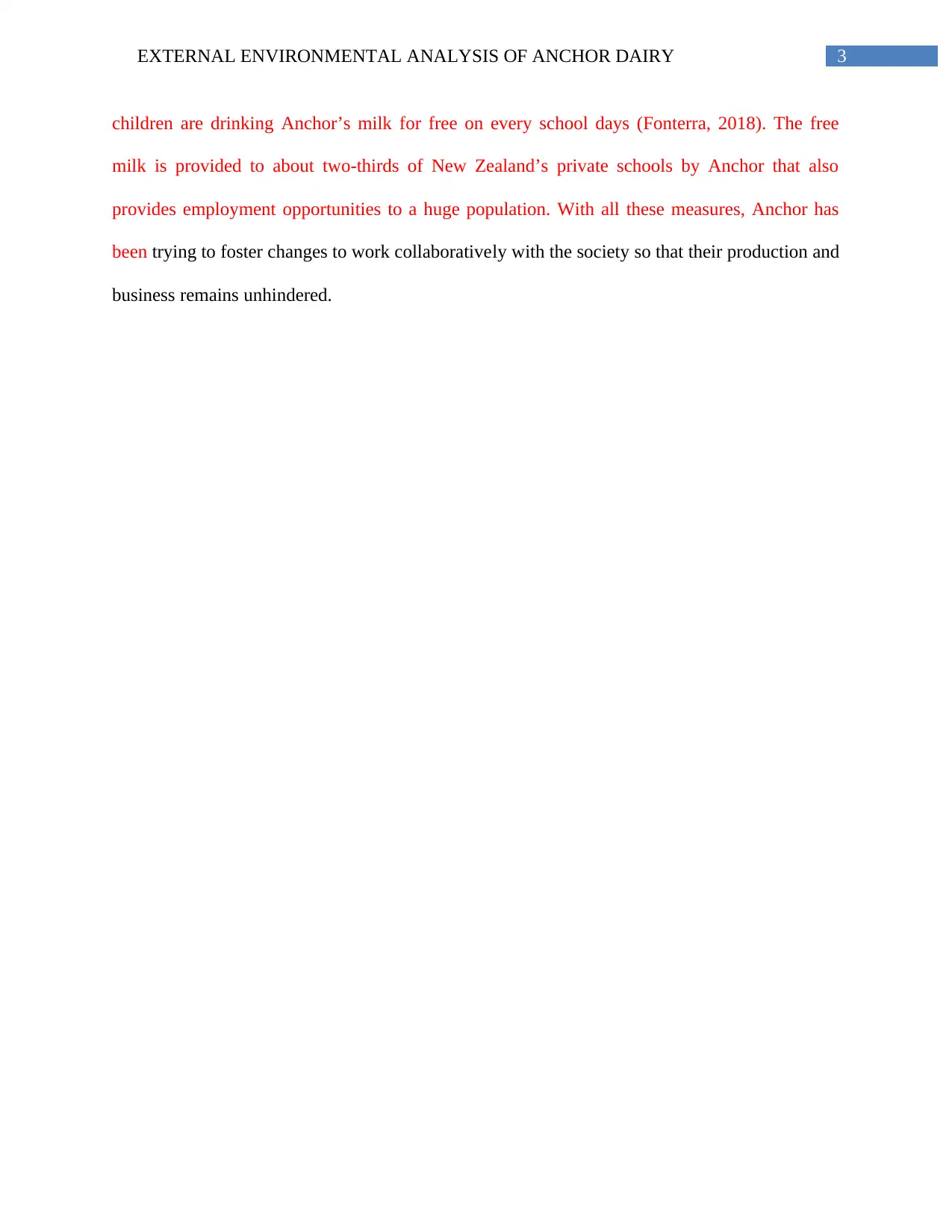
3EXTERNAL ENVIRONMENTAL ANALYSIS OF ANCHOR DAIRY
children are drinking Anchor’s milk for free on every school days (Fonterra, 2018). The free
milk is provided to about two-thirds of New Zealand’s private schools by Anchor that also
provides employment opportunities to a huge population. With all these measures, Anchor has
been trying to foster changes to work collaboratively with the society so that their production and
business remains unhindered.
children are drinking Anchor’s milk for free on every school days (Fonterra, 2018). The free
milk is provided to about two-thirds of New Zealand’s private schools by Anchor that also
provides employment opportunities to a huge population. With all these measures, Anchor has
been trying to foster changes to work collaboratively with the society so that their production and
business remains unhindered.
Paraphrase This Document
Need a fresh take? Get an instant paraphrase of this document with our AI Paraphraser
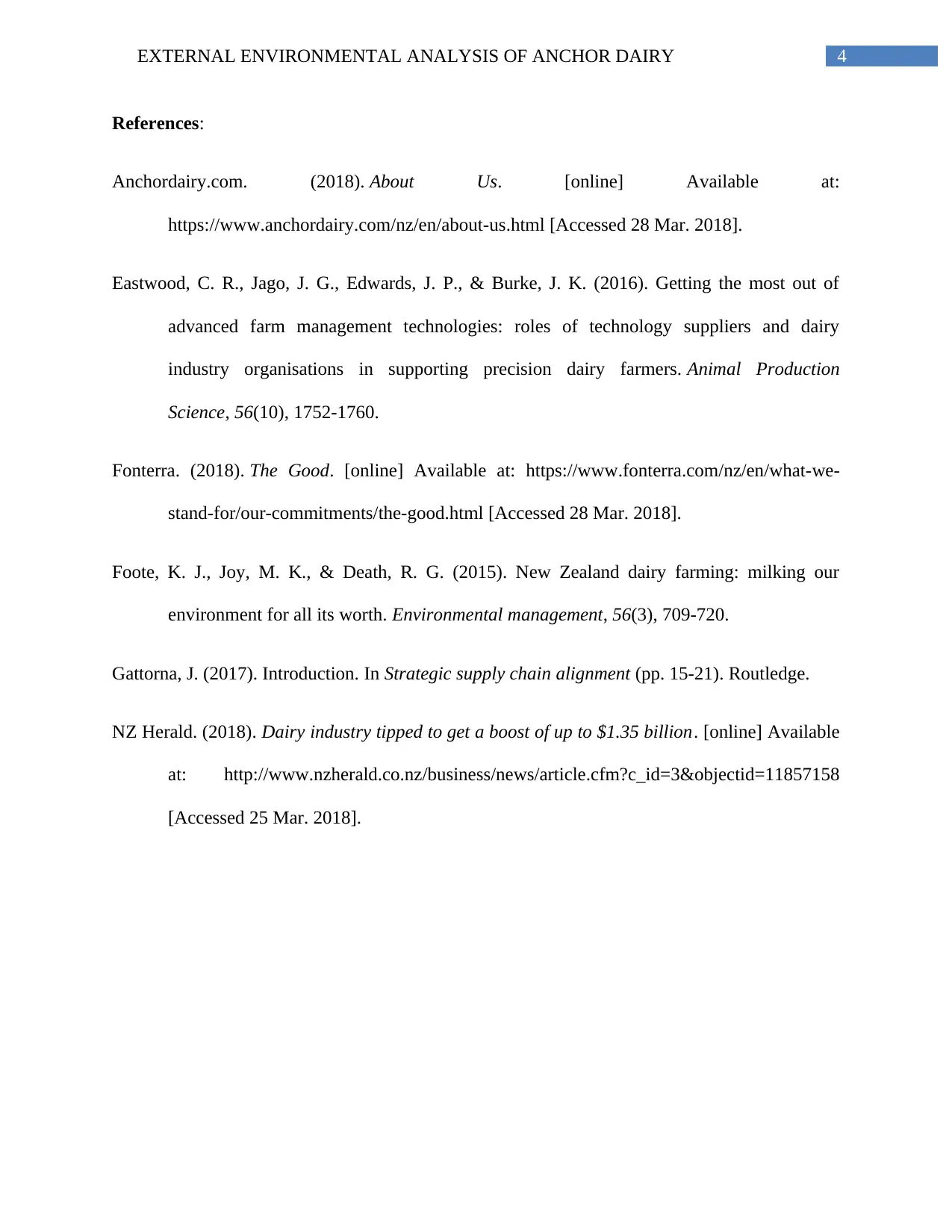
4EXTERNAL ENVIRONMENTAL ANALYSIS OF ANCHOR DAIRY
References:
Anchordairy.com. (2018). About Us. [online] Available at:
https://www.anchordairy.com/nz/en/about-us.html [Accessed 28 Mar. 2018].
Eastwood, C. R., Jago, J. G., Edwards, J. P., & Burke, J. K. (2016). Getting the most out of
advanced farm management technologies: roles of technology suppliers and dairy
industry organisations in supporting precision dairy farmers. Animal Production
Science, 56(10), 1752-1760.
Fonterra. (2018). The Good. [online] Available at: https://www.fonterra.com/nz/en/what-we-
stand-for/our-commitments/the-good.html [Accessed 28 Mar. 2018].
Foote, K. J., Joy, M. K., & Death, R. G. (2015). New Zealand dairy farming: milking our
environment for all its worth. Environmental management, 56(3), 709-720.
Gattorna, J. (2017). Introduction. In Strategic supply chain alignment (pp. 15-21). Routledge.
NZ Herald. (2018). Dairy industry tipped to get a boost of up to $1.35 billion. [online] Available
at: http://www.nzherald.co.nz/business/news/article.cfm?c_id=3&objectid=11857158
[Accessed 25 Mar. 2018].
References:
Anchordairy.com. (2018). About Us. [online] Available at:
https://www.anchordairy.com/nz/en/about-us.html [Accessed 28 Mar. 2018].
Eastwood, C. R., Jago, J. G., Edwards, J. P., & Burke, J. K. (2016). Getting the most out of
advanced farm management technologies: roles of technology suppliers and dairy
industry organisations in supporting precision dairy farmers. Animal Production
Science, 56(10), 1752-1760.
Fonterra. (2018). The Good. [online] Available at: https://www.fonterra.com/nz/en/what-we-
stand-for/our-commitments/the-good.html [Accessed 28 Mar. 2018].
Foote, K. J., Joy, M. K., & Death, R. G. (2015). New Zealand dairy farming: milking our
environment for all its worth. Environmental management, 56(3), 709-720.
Gattorna, J. (2017). Introduction. In Strategic supply chain alignment (pp. 15-21). Routledge.
NZ Herald. (2018). Dairy industry tipped to get a boost of up to $1.35 billion. [online] Available
at: http://www.nzherald.co.nz/business/news/article.cfm?c_id=3&objectid=11857158
[Accessed 25 Mar. 2018].
1 out of 5
Related Documents
Your All-in-One AI-Powered Toolkit for Academic Success.
+13062052269
info@desklib.com
Available 24*7 on WhatsApp / Email
![[object Object]](/_next/static/media/star-bottom.7253800d.svg)
Unlock your academic potential
Copyright © 2020–2025 A2Z Services. All Rights Reserved. Developed and managed by ZUCOL.





